 W
WAn electrical connector is an electromechanical device used to join electrical conductors and create an electrical circuit. Most electrical connectors have a gender – i.e. the male component, called a plug, connects to the female component, or socket. The connection may be removable, require a tool for assembly and removal, or serve as a permanent electrical joint between two points. An adapter can be used to join dissimilar connectors.
 W
WThe term Amphenol connector refers to various electronics connectors that are introduced, or made primarily by Amphenol Corp. Depending on the area of electronics concerned, it may refer specifically to:MIL-DTL-5015 / MIL-C-5015, a circular connector MIL-DTL-26482 / MIL-C-26482, a circular bayonet connector RJ21, used in aggregated telecommunications cabling Micro ribbon, used in personal computer's connection to printer or SCSI equipments ARINC 828, a repurposing of MIL-DTL-38999. UHF connector, a threaded RF coaxial connector A circular connector, usually consisting of 6, 9 or 11 pins, used to connect a Hammond organ to a Leslie speaker.
 W
WA bayonet mount or bayonet connector is a fastening mechanism consisting of a cylindrical male side with one or more radial pins, and a female receptor with matching L-shaped slot(s) and with spring(s) to keep the two parts locked together. The slots are shaped like a capital letter L with serif ; the pin slides into the vertical arm of the L, rotates across the horizontal arm, then is pushed slightly upwards into the short vertical "serif" by the spring; the connector is no longer free to rotate unless pushed down against the spring until the pin is out of the "serif".
 W
WA binding post is a connector commonly used on electronic test equipment to terminate (attach) a single wire or test lead. They are also found on loudspeakers and audio amplifiers as well as other electrical equipment.
 W
WA pin header is a form of electrical connector. A male pin header consists of one or more rows of metal pins molded into a plastic base, often 2.54 mm (0.1 in) apart, though available in many spacings. Male pin headers are cost-effective due to their simplicity. The female counterparts are sometimes known as female socket headers, though there are numerous naming variations of male and female connectors. Historically, headers have sometimes been called "Berg connectors", but headers are manufactured by many companies.
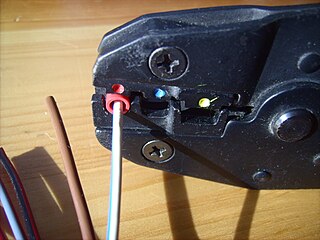 W
WAn electrical crimp is a type of solderless electrical connection.
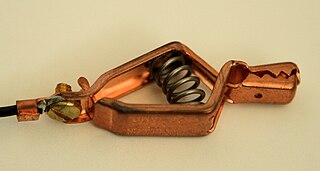 W
WA crocodile clip is a sprung metal clip with long, serrated jaws which is used for creating a temporary electrical connection. This simple mechanical device gets its name from the resemblance of its jaws to those of an alligator or crocodile. It is used to connect an electrical cable to a battery or some other component. Functioning much like a spring-loaded clothespin, the clip's tapered, serrated jaws are forced together by a spring to grip an object. When manufactured for electronics testing and evaluation, one jaw of the clip is typically permanently crimped or soldered to a wire, or is bent to form the inner tubular contact of a ~4 mm (0.16 in) female banana jack, enabling quick non-permanent connection between a circuit under test and laboratory equipment or to another electrical circuit. The clip is typically covered by a plastic shroud or "boot" to prevent accidental short-circuits.
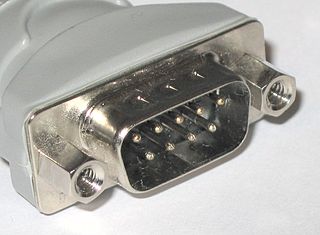 W
WThe D-subminiature or D-sub is a common type of electrical connector. They are named for their characteristic D-shaped metal shield. When they were introduced, D-subs were among the smallest connectors used on computer systems.
 W
WThe D subminiature military is a Cannon connector used in aerospace, military, aviation, and electric cars. It is also manufactured by other companies besides Cannon ITT. It has seven pins in a housing the same size as the standard 9-pin or 15-pin D-sub. There are five pins in two central rows and two large pins, one at each end. UL file number E8572.
 W
WAn edge connector is the portion of a printed circuit board (PCB) consisting of traces leading to the edge of the board that are intended to plug into a matching socket. The edge connector is a money-saving device because it only requires a single discrete female connector, and they also tend to be fairly robust and durable. They are commonly used in computers for expansion slots for peripheral cards, such as PCI, PCI Express, and AGP cards.
 W
WAn enhanced mini-USB (EMU) connector is a type of hybrid electrical connector which carries Universal Serial Bus data and power as well as other connections such as bidirectional audio. It was invented for and is mainly used on mobile phones. Motorola, HTC Corporation, and other mobile phone manufacturers use EMU connectors. There is more than one standard for EMU connectors, which are incompatible between manufacturers, but all are physically and electrically compatible with standard mini-USB connectors. The EMU connector has five pins for USB on one side. While regular USB connectors are empty on the other side, EMU has more pins intended for headsets. In HTC's version, two pins are for the microphone, three are for stereo sound, and one is for the push-to-talk switch.
 W
WThe FastPort was a proprietary polyconnection interface used on all Sony Ericsson cellphones between 2005 and 2010. Designed in response to Nokia's proprietary Pop-Port, FastPort provided data transfer, charging, headset and speaker connections through a common interface. It was discontinued in 2010 and replaced with a micro-USB for charging and data, and a TRRS connection for audio (headphones).
 W
WA pin header is a form of electrical connector. A male pin header consists of one or more rows of metal pins molded into a plastic base, often 2.54 mm (0.1 in) apart, though available in many spacings. Male pin headers are cost-effective due to their simplicity. The female counterparts are sometimes known as female socket headers, though there are numerous naming variations of male and female connectors. Historically, headers have sometimes been called "Berg connectors", but headers are manufactured by many companies.
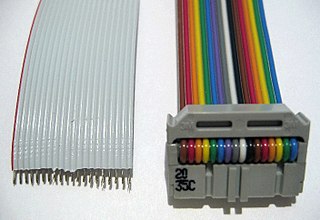 W
WAn insulation-displacement contact (IDC), also known as insulation-piercing contact (IPC), is an electrical connector designed to be connected to the conductor(s) of an insulated cable by a connection process which forces a selectively sharpened blade or blades through the insulation, bypassing the need to strip the conductors of insulation before connecting. When properly made, the connector blade cold-welds to the conductor, making a theoretically reliable gas-tight connection.
 W
WFischer Connectors is a Swiss multinational corporation that designs, manufactures and distributes electrical connectors and optical fiber connectors, cable assemblies and connectivity systems. Founded in 1954, the company’s headquarters with its manufacturing facility and R&D Center is based in Saint-Prex, Switzerland. Fischer Connectors has eight subsidiaries employing 550 people worldwide, with cable assembly facilities in Europe, North America and Asia Pacific and a global network of distributors and agents. Fischer Connectors’ circular connectors, electrical and optical cable assemblies and integrated systems are used in aerospace, broadcast, defense, energy, food, industrial, instrumentation, marine, medical, nuclear, oil and gas, pharmaceutical, robotics, security, transportation and vacuum applications. Fischer Connectors’ range of products includes over 30,000 standard electrical, optical and hybrid connectors and cable assemblies organized across five product lines engineered to fulfill needs in terms of high-reliability connectivity, miniaturization, high-speed data transfer, sealing and wearability. Connectors are produced in different materials such as brass, stainless steel, aluminum and plastic. Their design and configurations vary from miniature and high-density signal & power connectors to compact, rugged, sealed and hermetic connectors made to withstand extreme conditions. In 2018, Fischer Connectors launched a plug & use connector with 360° mating and a low profile for integration into wearable devices and various applications in the Internet of Things. Fischer Connectors’ finished products include ruggedized flash drives for data transfer and storage. The company also provides customized products for design engineers’ projects requiring non-standard specifications.
 W
WFlat Flexible Cable, or FFC, refers to any variety of electrical cable that is both flat and flexible, with flat solid conductors. A flexible flat cable is a type of flexible electronics. However, the term FFC usually refers to the extremely thin flat cable often found in high-density electronic applications like laptops and cell phones.
 W
WA bipin or bi-pin is a type of lamp fitting. They are included in the IEC standard "IEC 60061 Lamp caps and holders together with gauges for the control of interchangeability and safety". They are used on many small incandescent light bulbs, and for starters on some types of fluorescent lights.
 W
WA bipin or bi-pin is a type of lamp fitting. They are included in the IEC standard "IEC 60061 Lamp caps and holders together with gauges for the control of interchangeability and safety". They are used on many small incandescent light bulbs, and for starters on some types of fluorescent lights.
 W
WA bipin or bi-pin is a type of lamp fitting. They are included in the IEC standard "IEC 60061 Lamp caps and holders together with gauges for the control of interchangeability and safety". They are used on many small incandescent light bulbs, and for starters on some types of fluorescent lights.
 W
WA bipin or bi-pin is a type of lamp fitting. They are included in the IEC standard "IEC 60061 Lamp caps and holders together with gauges for the control of interchangeability and safety". They are used on many small incandescent light bulbs, and for starters on some types of fluorescent lights.
 W
WThe game port, originally introduced on the Game Control Adapter, is a device port that was found on IBM PC compatible and other computer systems throughout the 1980s and 1990s. It was the traditional connector for joystick input, and occasionally MIDI devices, until obsoleted by USB in the late 1990s.
 W
WIn electrical and mechanical trades and manufacturing, each half of a pair of mating connectors or fasteners is conventionally assigned the designation male or female. The female connector is generally a receptacle that receives and holds the male connector. Sometimes the terms plug and socket or jack are used, particularly in reference to electrical connectors. In some cases, the pins on the connector may have the opposite nominal gender to the mounted connector, such as the RCA connector.
 W
WA bipin or bi-pin is a type of lamp fitting. They are included in the IEC standard "IEC 60061 Lamp caps and holders together with gauges for the control of interchangeability and safety". They are used on many small incandescent light bulbs, and for starters on some types of fluorescent lights.
 W
WA bipin or bi-pin is a type of lamp fitting. They are included in the IEC standard "IEC 60061 Lamp caps and holders together with gauges for the control of interchangeability and safety". They are used on many small incandescent light bulbs, and for starters on some types of fluorescent lights.
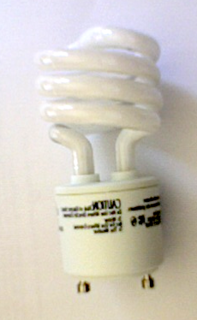 W
WA GU24 lamp fitting is a bi-pin connector for compact fluorescent lamps (CFL) or LED lamps that uses a bayonet mount–like twist-lock bi-pin connector instead of the Edison screw fitting used on many CFLs, LED lamps and incandescent light bulbs. The design was initiated by the U.S. EPA and the Lighting Research Center in 2004, in order to facilitate the deployment of compact fluorescent light bulbs with replaceable ballasts.
 W
WA pin header is a form of electrical connector. A male pin header consists of one or more rows of metal pins molded into a plastic base, often 2.54 mm (0.1 in) apart, though available in many spacings. Male pin headers are cost-effective due to their simplicity. The female counterparts are sometimes known as female socket headers, though there are numerous naming variations of male and female connectors. Historically, headers have sometimes been called "Berg connectors", but headers are manufactured by many companies.
 W
WAn insulation-displacement contact (IDC), also known as insulation-piercing contact (IPC), is an electrical connector designed to be connected to the conductor(s) of an insulated cable by a connection process which forces a selectively sharpened blade or blades through the insulation, bypassing the need to strip the conductors of insulation before connecting. When properly made, the connector blade cold-welds to the conductor, making a theoretically reliable gas-tight connection.
 W
WITT Interconnect Solutions, a division of ITT Inc., is a globally diversified connector and connector assembly manufacturing company. Founded in 1915 as Cannon by James H. Cannon, the company developed some of the first equipment for sound films in the early years of the movie industry, including a synchronous motor drive to remotely operate a motion picture projector together with a phonograph. The first "Cannon plug", the M-1 connector, was initially designed as a quick grounding connection for the electrical motor on a portable meat grinder and was adapted for movie sound equipment, enabling the new electrical camera to move freely about while “shooting” a scene. Cannon's M-1 connector was incorporated into the sound equipment used to make the first "talking" motion picture, The Jazz Singer. Cannon continued to develop connectors for the entertainment industry, including the “P” Series audio connectors developed for Paramount Studios, as well as connectors used in the first radio microphones, the first black-and-white television cameras, and the first color television equipment.
 W
WA low-force helix (LFH-60) is a 60-pin electrical connector with signals for two digital and analog connectors. Each of the pins is twisted approximately 45 degrees between the tip and the plastic frame which holds the pins in place. Hence "helix" in the name.
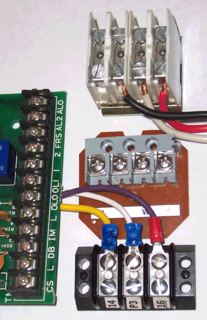 W
WA screw terminal is a type of electrical connection where a wire is held by the tightening of a screw.
 W
WA pin header is a form of electrical connector. A male pin header consists of one or more rows of metal pins molded into a plastic base, often 2.54 mm (0.1 in) apart, though available in many spacings. Male pin headers are cost-effective due to their simplicity. The female counterparts are sometimes known as female socket headers, though there are numerous naming variations of male and female connectors. Historically, headers have sometimes been called "Berg connectors", but headers are manufactured by many companies.
 W
WA pin header is a form of electrical connector. A male pin header consists of one or more rows of metal pins molded into a plastic base, often 2.54 mm (0.1 in) apart, though available in many spacings. Male pin headers are cost-effective due to their simplicity. The female counterparts are sometimes known as female socket headers, though there are numerous naming variations of male and female connectors. Historically, headers have sometimes been called "Berg connectors", but headers are manufactured by many companies.
 W
WA pin header is a form of electrical connector. A male pin header consists of one or more rows of metal pins molded into a plastic base, often 2.54 mm (0.1 in) apart, though available in many spacings. Male pin headers are cost-effective due to their simplicity. The female counterparts are sometimes known as female socket headers, though there are numerous naming variations of male and female connectors. Historically, headers have sometimes been called "Berg connectors", but headers are manufactured by many companies.
 W
WMIL-DTL-5015 is a United States Military Standard which covers heavy-duty circular electrical connectors with soldered or crimped contacts. They are used for both digital and analog signals, as well as power distribution, and are common in various fields, including defense, aerospace, and industrial machinery. The connectors are particularly versatile and reliable, and due to their prevalence, relatively inexpensive.
 W
WThe Pop-Port interface was a proprietary plug-in port for accessories and data synchronisation, available with many Nokia mobile phones. The port consists of one metal pin on either end, and a plastic tab containing thirteen contacts. Pop-Port-like interfaces first appeared in Nokia phones since circa 1996, but the Pop-Port was standardised as a single interface in 2002.
 W
WA pin header is a form of electrical connector. A male pin header consists of one or more rows of metal pins molded into a plastic base, often 2.54 mm (0.1 in) apart, though available in many spacings. Male pin headers are cost-effective due to their simplicity. The female counterparts are sometimes known as female socket headers, though there are numerous naming variations of male and female connectors. Historically, headers have sometimes been called "Berg connectors", but headers are manufactured by many companies.
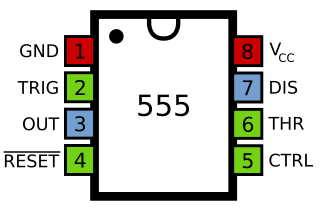 W
WIn electronics, a pinout is a cross-reference between the contacts, or pins, of an electrical connector or electronic component, and their functions. "Pinout" now supersedes the term "basing diagram" that was the standard terminology used by the manufacturers of vacuum tubes and the RMA. The RMA started its standardization in 1934, collecting and correlating tube data for registration at what was to become the EIA. The EIA now has many sectors reporting to it, and sets what are known as EIA standards where all registered pinouts and registered jacks can be found.
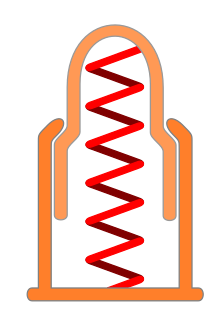 W
WA pogo pin or spring-loaded pin is a type of electrical connector mechanism that is used in many modern electronic applications and in the electronics testing industry. They are used for their improved durability over other electrical contacts, and the resilience of their electrical connection to mechanical shock and vibration.
 W
WPositronic is a manufacturing company based in Springfield, Missouri. The company manufactures and supplies electronic connectors that are utilized in a variety of industries worldwide including military, aerospace, telecommunications, medical, industrial and test equipment among others.
 W
WA Prontor-Compur connection is a standard 3.5 mm (1/8") electrical connector used in photography to synchronize the shutter to the flash.
 W
WQ-Connector or ASUS Q-Connector, is an adapter, sometimes included with ASUS motherboards, which sits in between the motherboard front panel connectors and the front panel cables. The Q-Connector is marked with bigger text than the front panel connectors on the motherboard, as well as protruding from the motherboard, limiting obstruction from heatsinks and other connectors.
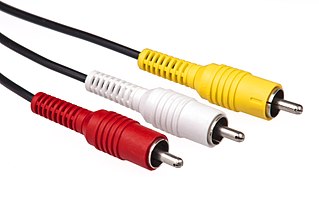 W
WThe RCA connector is a type of electrical connector commonly used to carry audio and video signals. The name RCA derives from the company Radio Corporation of America, which introduced the design in the 1930s. The connectors male plug and female jack are called RCA plug and RCA jack.
 W
WSAE J3068 is a North American recommended practice published and maintained by SAE International. J3068 defines electrical connectors and a control protocol for electric vehicles. It has the formal title "SAE Surface Vehicle Recommended Practice J3068". J3068 defines a system of conductive power transfer to an electric vehicle using a coupler capable of transferring single-phase and three-phase AC power as well as DC power, and defines a digital communication system for control. J3068 also specifies requirements for the vehicle inlet, supply equipment connector, mating housings and contacts.
 W
WA screw terminal is a type of electrical connection where a wire is held by the tightening of a screw.
 W
WA pin header is a form of electrical connector. A male pin header consists of one or more rows of metal pins molded into a plastic base, often 2.54 mm (0.1 in) apart, though available in many spacings. Male pin headers are cost-effective due to their simplicity. The female counterparts are sometimes known as female socket headers, though there are numerous naming variations of male and female connectors. Historically, headers have sometimes been called "Berg connectors", but headers are manufactured by many companies.
 W
WA smart plug is a power plug which can be fitted between power cords and sockets to function as a remote controlled power switch. As such, smart plugs can be used to make "dumb" electrical equipment "smart" and thereby enable such devices for home automation or building automation purposes.
 W
WA thermal relief pad, thermal pad or simply thermal, is a printed circuit board (PCB) pad connected to a copper pour using a thermal connection. It looks like a normal pad with copper "spokes" connecting it to the surrounding copper.
 W
WElectrical or fiber-optic connectors used by U.S. Department of Defense were originally developed in the 1930s for severe aeronautical and tactical service applications, and the Type "AN" (Army-Navy) series set the standard for modern military circular connectors. These connectors, and their evolutionary derivatives, are often called Military Standard, "MIL-STD", or (informally) "MIL-SPEC" or sometimes "MS" connectors. They are now used in aerospace, industrial, marine, and even automotive commercial applications.
 W
WA wedge base is a type of electrical connector used as a fitting for small light bulbs. It is similar to the bi-pin connector, except that the two "pins" are the same wires that extend into the bulb, and the wires are bent up onto the sides of the base, where they make contact with the socket. The wires are usually inserted into a plastic base that the bulb is mounted in, and which is often narrower at the tip than at the bulb, giving it a wedge shape and usually ensuring a tight connection, depending on manufacturing tolerances. Some bulbs have no plastic base, and the wires are simply bent up to the sides of the bulb's glass base.